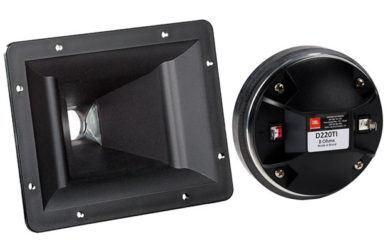| The Pyle PH565 horn measures 7-5/8″W x 6-1/8″H, making it an ideal candidate for 8″ woofer. It has a coverage of 90°H x 40°V, a cut-off frequency of 1kHz, 1-3/8″-18 screw mount and made of ABS resin.
I’m not sure whether Pyle discontinued this horn but there’s one made by Goldwood, model GT-300PB. I believe they are exactly the same. |
 |
| Selenium D220Ti with Pyle PH565
Fig 1 shows the response of the Selenium D220Ti with the Pyle PH565 horn. BLACK trace = RAW (no crossover) No CDEQ activated. Microphone at 1 meter, tweeter axis. Gating at 5 msec. No smoothing applied. From the plots, we can see some jagged response from 4kHz to 7Khz. Fortunately, these frequencies are not too critical as they are out of the vocal range. |
 (Fig 1) Frequency Response of Selenium D220Ti with Pyle PH565 |
| Improper Summing
The Red trace in Fig 2 is the summed response of a Dayton RS180S with the Selenium D220Ti/PH565. Some cancellation is observed on the right of the crossover frequency. |
 (Fig 2) Vertical Scale = 5dB/DIV |
| D220Ti in Reverse Phase
In Fig 3, the Selenium D220Ti is wired in reverse phase. The summed response shows quite a displacement between the acoustic centers of the D220Ti and the RS180S. |
 (Fig 3) Selenium D220Ti in Reverse Phase |
| Applying Delay
In Fig 4, delay is applied to the RS180S. With the right amount, a deep notch is observed, which will be centered at the crossover frequency. |
 (Fig 4) Delay added to Dayton RS180S |
| Time Aligned RS180S and D220Ti/PH565
Fig 5 is the time aligned summed response when the D220Ti is wired back to normal phase. Note the cancellation in Fig 2 has completely disappeared. |
 (Fig 5) Time Aligned RS180S and D220Ti?ph565 |

November 30, 2016PRO DRIVERS